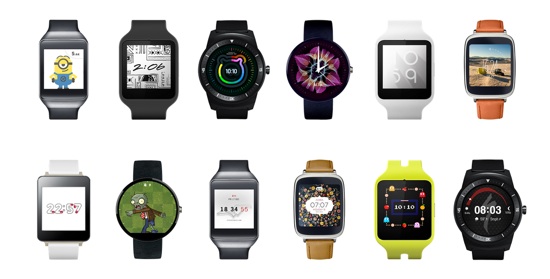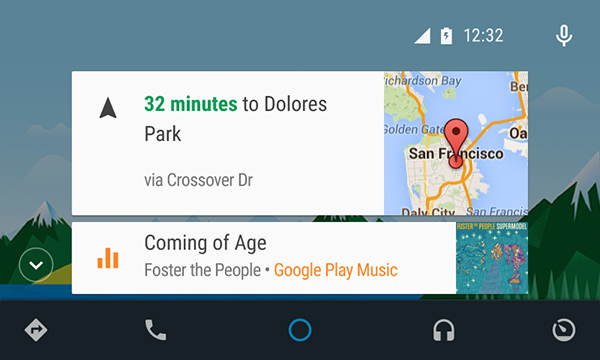
Android has never enjoyed quite the same fanboy enthusiasm among its users as Apple’s iOS or desktop Linux. Yet, thanks in part to the fairly open licensing of the Linux-based mobile OS, Android quickly evolved and improved. Like Google Search, it quietly crept into our lives, and decided to stay. Android smartphones and tablets now represent about 80 percent and 70 percent global market share, respectively (see the companion article, Android Dominates Global Smartphone Market in 2014.)
2014 was the year that Android aggressively expanded into new categories, as Google established major new profiles for Android smartwatches and wearables (Android Wear), TVs and set-tops (Android TV), and car computers (Android Auto). The expansion opens new opportunities while also posing new challenges in fragmentation.
Lollipop: Not just for smartphones
The new profiles continue a process of diversification into embedded form factors that began years ago, with both Google-backed projects such as the failed Google TV, the struggling Google Glass, and a variety of third-party ports to new device types. The difference now is that Android Wear, TV, and Auto are all based on a common, unifying Android 5.0 (“Lollipop”) release.
Theoretically developers can write a single app that can be ported to all of these platforms, as well as tablets and smartphones. Lollipop also provides a more consistent UI across diverse devices, including Google’s voice-driven AI genie, Google Now.
Lollipop offers improved notifications, security enhancements such as automatic Full Disk Encryption (FDE), and a stylish, yet subdued look and feel. Android now supports more capable 64-bit processors, thanks to replacing the Dalvik runtime with Android Runtime (ART), which uses an AOT (ahead-of-time) compiler. The compiler helps improves overall performance, and, with the help of other Lollipop enhancements, extends battery life.
Benchmarks have confirmed varying levels of performance improvements, depending on the source. However, storage performance degrades considerably when you activate the new FDE encryption feature, according to Anandtech.
Android Wear evolves before our eyes
Of the three device profiles that build upon Android 5.0, Android Wear is the most established. Like the first Android phones, the first Android Wear smartwatches were pretty unremarkable. Yet, more recent models such as the Sony Smartwatch 3, using later Android Wear revisions, have garnered better reviews. Vendors are finding out what people want from their smartwatches and are tweaking the devices accordingly. The same goes for Google and Android Wear itself.
 Android Auto and Android TV are still works in progress. Initially, Auto is not a full IVI specification, but an effort like Apple CarPlay to ease the integration of mobile devices with existing IVI gear. It could become much more than that if Google can convince auto manufacturers to join in. Considering how Google’s Linux-based Self Driving Car has upstaged the automakers’ own autonomous roadmaps, Google may have a tough time turning this into a full automotive spec.
Android Auto and Android TV are still works in progress. Initially, Auto is not a full IVI specification, but an effort like Apple CarPlay to ease the integration of mobile devices with existing IVI gear. It could become much more than that if Google can convince auto manufacturers to join in. Considering how Google’s Linux-based Self Driving Car has upstaged the automakers’ own autonomous roadmaps, Google may have a tough time turning this into a full automotive spec.
Android TV, meanwhile, must shed the ghosts of Google TV past while learning from the experience. For example, Google’s hardware requirements are now less specific, giving more leeway to vendors of TVs and set-tops. Another difference is that Android TV seems to be as focused on gaming as it is on the integrated TV experience. In a recent Forbes interview Android TV engineering manager Chris McKillop barely touched on TV, focusing entirely on games.
While Google spins these new vertical variants, diversification continues independently in third-party builds running on devices within and without these categories. A growing number of Android-based media players, set-tops, in-vehicle infotainment computers, smartwatches, smart goggles, signage computers, Point of Sale devices, and all-in-one (AiO) desktops have appeared in 2014. We’ve even seen some Android-based robots, drones, industrial equipment, and home automation devices.
Many of these devices don’t require the Google Apps from which Google makes much of its Android profits. Vendors big and small can download open source code from AOSP and head out on their own.
Android’s further migration into consumer electronics and embedded tech has been encouraged by growing contributions of Android code to the Linux kernel, as well as efforts such as Linaro, which helps standardize embedded development of Linux and Android on ARM platforms. Device developers can now develop much of the design first, before deciding which flavor of Linux to employ, whether it is Android, Yocto, Ubuntu, or various derivatives of Debian and other Linux rootstock. Android tends to win out when multiple apps are required, or if there’s a particularly sophisticated touchscreen interface.
Fragmentation: Better and Worse
It will be interesting to see if Android 5.0 is as unifying as Google claims. After all, it’s bridging a mighty distance between devices as different as in-vehicle infotainment systems and smartwatches. Even if app development is eased somewhat, the diversification potentially revives some of the fragmentation worries that threatened to derail Android in years past.
Despite the increasing diversity of the Android ecosystem, you don’t hear many complaints about fragmentation anymore. This is primarily because Google and its hardware partners have done a better job pushing out new releases on the platforms where timeliness matters the most: smartphones and tablets.
Lollipop is already well on its way to appearing on most major new mobile devices, starting with a Motorola-built Nexus 6 phablet featuring the quad-core, 2.7GHz Qualcomm Snapdragon 805 processor. Android 5.0 also ships on the HTC manufactured Nexus 9 tablet, which debuts the 64-bit “Denver” version of the Nvidia Tegra K1 chip. Intel gets the nod on the first Android TV media player, a Lollipop-based Nexus Player set-top with a quad-core Intel Atom.
Despite faster upgrades, Android is in some ways more fragmented now than ever. An OpenSignal report on fragmentation in August estimated that Android developers face the daunting challenge of potentially writing for 18,796 distinct Android devices, 11,868 of which have appeared only in the last year.
While the number of major device profiles is far fewer than that, fragmentation is increasing from the growing number of manufacturers, screen sizes, and new hardware features, says the report. For example, the latest high-end phones now offer a variety of environmental and ambient light sensors, and in some cases even heart rate sensors and biometric scanners.
Google’s Android-based Project Tango points to a near future where mobile devices use sensors to build 3D scenes for augmented reality applications, including indoor navigation and immersive gaming. Meanwhile, Google’s simple, affordable Cardboard stereoscopic viewing kit could turn into a major platform for augmenting mobile devices with virtual reality. Then there’s the rumored Intel-based revamp of Google Glass.
In 2015 we may see how Google plans to integrate all these augmented reality projects, as well as related efforts such as gaming on Android TV. In 2015, we are likely to see more signs of Android’s evolution into an increasingly immersive, augmented reality future. We may also see a glimpse of how Google might attempt to integrate Android and its increasingly popular Chrome OS.


